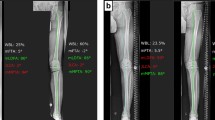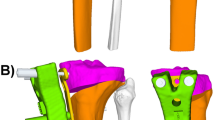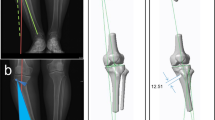Abstract
Purpose
We report our experience with a 3D patient-specific instrument (PSI) in an opening-wedge tibial osteotomy for the correction of varus malalignment in a patient with prior anterior cruciate ligament reconstruction. Previous studies have not reported the use of 3D PSI in patients with prior knee surgeries.
Methods
A pre-operative CT was used to create a 3D model of the lower extremity using Bodycad Imager. The pre-operative medial proximal tibial angle (MPTA), lateral distal femoral ankle, hip-knee-ankle (HKA), and tibial slope were calculated. The Bodycad Osteotomy software package was used to create a simulated osteotomy and correction. The resulting 3D patient-specific surgical guide and plate were used to conduct the high tibial osteotomy. Radiographic measurements and range of motion were evaluated at 6-week follow-up.
Results
The arthroscopy and open portions of the procedure were performed in 65 min, with only three fluoroscopy shots taken intraoperatively. At 6-week follow-up, the patient had 125° of flexion and minimal pain. The angular correction of the bone was achieved within 1.9° (planned MPTA 91.9° vs. actual 90°); the HKA angle was achieved with an error of 0.7° (planned 2.4° vs. actual 1.7°); and there was no change in the posterior tibial slope (planned 13.5° vs 13.8° actual).
Conclusion
Three-dimensional PSI can be successfully used for the accurate and efficient correction of varus malalignment while accommodating pre-existing hardware, with good short-term clinical outcomes.



















Similar content being viewed by others
References
Rossi R, Bonasia DE, Amendola A (2011) The role of high tibial osteotomy in the varus knee . J Am Acad Orthop Surg 19(10):590–599. https://doi.org/10.5435/00124635-201110000-00003
Debarge R, Trouillet F, Demey G, Magnussen RA (2014) High tibial osteotomy. Surg Knee 24:149–161
Akamatsu Y, Mitsugi N, Mochida Y, Taki N, Kobayashi H, Takeuchi R et al (2012) Navigated opening wedge high tibial osteotomy improves intraoperative correction angle compared with conventional method. Knee Surg Sport Traumatol Arthrosc 20:586–593
Kwun J-D, Kim H-J, Park J, Park I-H, Kyung H-S (2017) Open wedge high tibial osteotomy using three-dimensional printed models: experimental analysis using porcine bone. Knee 24:16–22
Kawakami H, Sugano N, Yonenobu K, Yoshikawa H, Ochi T, Hattori A et al (2004) Effects of rotation on measurement of lower limb alignment for knee osteotomy. J Orthop Res 22:1248–1253
Yang JCS, Chen CF, Luo CA, Chang MC, Lee OK, Huang Y et al (2018) Clinical experience using a 3D-printed patient-specific instrument for medial opening wedge high tibial osteotomy. Biomed Res Int 2018
Jones GG, Jaere M, Clarke S, Cobb J (2018) 3D printing and high tibial osteotomy. EFORT Open Rev Br Ed Soc Bone Jt Surg 3:254–259
Martin R, Birmingham TB, Willits K, Litchfield R, Lebel M-E, Giffin JR (2014) Adverse event rates and classifications in medial opening wedge high tibial osteotomy. Am J Sports Med 42:1118–1126
Coventry MB (1965) Osteotomy of the upper portion of the tibia for degenerative arthritis of the knee: a preliminary report. J Bone Joint Surg Am 47:984–90
Ivarsson I, Myrnerts R, Gillquist J (1990) High tibial osteotomy for medial osteoarthritis of the knee. A 5 to 7 and an 11 to 13 year follow-up. J Bone Jt Surg Ser B 72:238–244
Akamatsu Y, Kumagai K, Kobayashi H, Tsuji M, Saito T (2018) Effect of Increased coronal inclination of the tibial plateau after opening-wedge high tibial osteotomy. Arthrosc J Arthrosc Relat Surg 34:2158–2169
Goshima K, Sawaguchi T, Shigemoto K, Iwai S, Fujita K, Yamamuro Y (2019) Comparison of clinical and radiologic outcomes between normal and overcorrected medial proximal tibial angle groups after open-wedge high tibial osteotomy. Arthroscopy 35:2898–2908
Pérez-Mañanes R, Burró JA, Manaute JR, Rodriguez FC, Martín JV (2016) 3D Surgical printing cutting guides for open-wedge high tibial osteotomy: do it yourself. J Knee Surg 29:690–695
Dean CS, Liechti DJ, Chahla J, Moatshe G, LaPrade RF (2016) Clinical outcomes of high tibial osteotomy for knee instability: a systematic review. Orthop J Sport Med 4:2325967116633419
Noyes FR, Goebel SX, West J (2005) Opening wedge tibial osteotomy: the 3-triangle method to correct axial alignment and tibial slope. Am J Sports Med 33:378–387
El-Azab H, Halawa A, Anetzberger H, Imhoff AB, Hinterwimmer S (2008) The effect of closed- and open-wedge high tibial osteotomy on tibial slope: a retrospective radiological review of 120 cases. J Bone Jt Surg Ser B 90:1193–1197
Hernigou P (2002) Open wedge tibial osteotomy: combined coronal and sagittal correction. Knee 9:15–20
Van den Bempt M, Van Genechten W, Claes T, Claes S (2016) How accurately does high tibial osteotomy correct the mechanical axis of an arthritic varus knee? A systematic review. Knee 23:925–935
Marti CB, Gautier E, Wachtl SW, Jakob RP (2004) Accuracy of frontal and sagittal plane correction in open-wedge high tibial osteotomy. Arthroscopy 20:366–372
Bae DK, Song SJ, Yoon KH (2009) Closed-wedge high tibial osteotomy using computer-assisted surgery compared to the conventional technique. J Bone Jt Surg Ser B 91:1164–1171
Yan J, Musahl V, Kay J, Khan M, Simunovic N, Ayeni OR (2016) Outcome reporting following navigated high tibial osteotomy of the knee: a systematic review. Knee Surg Sport Traumatol Arthrosc 24:3529–3555
Wu ZP, Zhang P, Bai J, Liang Y, Chen PT, He JS et al (2018) Comparison of navigated and conventional high tibial osteotomy for the treatment of osteoarthritic knees with varus deformity: a meta-analysis. Int J Surg 55:211–219
Jang K-M, Lee J-H, Cho IY, Park B-K, Han S-B (2017) Intraoperative fluoroscopic assessment of limb alignment is a reliable predictor for postoperative limb alignment in biplanar medial opening-wedge high tibial osteotomy. J Arthroplasty 32:756–760
Yoon S-D, Zhang G, Kim H-J, Lee B-J, Kyung H-S (2016) Comparison of cable method and miniaci method using picture archiving and communication system in preoperative planning for open wedge high tibial osteotomy. Knee Surg Relat Res 28:283–288
Victor J, Premanathan A (2013) Virtual 3D planning and patient specific surgical guides for osteotomies around the knee: a feasibility and proof-of-concept study. Bone Jt J 95-B:153–158
Donnez M, Ollivier M, Munier M, Berton P, Podgorski JP, Chabrand P et al (2018) Are three-dimensional patient-specific cutting guides for open wedge high tibial osteotomy accurate? An in vitro study. J Orthop Surg Res 13:171
Munier M, Donnez M, Ollivier M, Flecher X, Chabrand P, Argenson J-N et al (2017) Can three-dimensional patient-specific cutting guides be used to achieve optimal correction for high tibial osteotomy? Pilot study Orthop Traumatol Surg Res 103:245–250
Kim HJ, Park J, Shin JY, Park IH, Park KH, Kyung HS (2018) More accurate correction can be obtained using a three-dimensional printed model in open-wedge high tibial osteotomy. Knee Surg Sport Traumatol Arthrosc 26:3452–3458
Hankemeier S, Hufner T, Wang G, Kendoff D, Zeichen J, Zheng G et al (2006) Navigated open-wedge high tibial osteotomy: advantages and disadvantages compared to the conventional technique in a cadaver study. Knee Surg Sports Traumatol Arthrosc 14:917–921
Funding
No funding was received for this study.
Author information
Authors and Affiliations
Corresponding author
Ethics declarations
Ethical declaration
We certify that our analysis complies with the ethical standards of our institution as well as laws related to research conducted in the USA.
Conflict of interest
A.F.K. reports the following disclosures: research support (Signature Orthopaedics), paid presenter or speaker (DePuy Synthes and Zimmer Biomet), paid consultant (DePuy Synthes and Zimmer Biomet), stock or stock options (Zimmer Biomet, Johnson & Johnson, and Procter & Gamble), IP royalties (Innomed), and board or committee member (AAOS, AAHKS, and Anterior Hip Foundation). L.T.S., A.J.A., J.M.K., and A.E. have nothing to disclose.
Additional information
Publisher's Note
Springer Nature remains neutral with regard to jurisdictional claims in published maps and institutional affiliations.
Rights and permissions
About this article
Cite this article
Jeong, S.H., Samuel, L.T., Acuña, A.J. et al. Patient-specific high tibial osteotomy for varus malalignment: 3D-printed plating technique and review of the literature. Eur J Orthop Surg Traumatol 32, 845–855 (2022). https://doi.org/10.1007/s00590-021-03043-8
Received:
Accepted:
Published:
Issue Date:
DOI: https://doi.org/10.1007/s00590-021-03043-8




